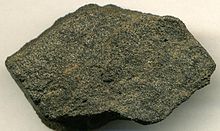Sodium is a chemical element with the symbol Na (from Latin natrium) and atomic number 11. It is a soft, silvery-white, highly reactive metal.
https://en.wikipedia.org/wiki/Sodium
Phosphorous can refer to:
- Phosphorus hydrides (4 P)
M
- Metal hydrides (78 P)
B
- Borohydrides (12 P)
High-energy phosphate can mean one of two things:
- The phosphate-phosphate (phosphoanhydride/phosphoric anhydride/macroergic/phosphagen)[1][2][3] bonds formed when compounds such as adenosine diphosphate (ADP) and adenosine triphosphate (ATP) are created.
- The compounds that contain these bonds, which include the nucleoside diphosphates and nucleoside triphosphates, and the high-energy storage compounds of the muscle, the phosphagens. When people speak of a high-energy phosphate pool, they speak of the total concentration of these compounds with these high-energy bonds.
High-energy phosphate bonds are usually pyrophosphate bonds, acid anhydride linkages formed by taking phosphoric acid derivatives and dehydrating them. As a consequence, the hydrolysis of these bonds is exergonic under physiological conditions, releasing energy.
| Reaction |
|---|
| ATP + H2O → ADP + Pi |
| ADP + H2O → AMP + Pi |
| ATP + H2O → AMP + PPi |
| PPi + H2O → 2 Pi |
https://en.wikipedia.org/wiki/High-energy_phosphate
In chemistry, pyrophosphates are phosphorus oxyanions that contain two phosphorus atoms in a P–O–P linkage. A number of pyrophosphate salts exist, such as disodium pyrophosphate (Na2H2P2O7) and tetrasodium pyrophosphate (Na4P2O7), among others. Often pyrophosphates are called diphosphates. The parent pyrophosphates are derived from partial or complete neutralization of pyrophosphoric acid. The pyrophosphate bond is also sometimes referred to as a phosphoanhydride bond, a naming convention which emphasizes the loss of water that occurs when two phosphates form a new P–O–P bond, and which mirrors the nomenclature for anhydrides of carboxylic acids. Pyrophosphates are found in ATP and other nucleotide triphosphates, which are very important in biochemistry.
https://en.wikipedia.org/wiki/Pyrophosphate
https://en.wikipedia.org/wiki/Tetrasodium_pyrophosphate
Lombricine is a phosphagen that is unique to earthworms. Structurally, it is a phosphodiester of 2-guanidinoethanol and D-serine (not the usual L-serine),[1] which is then further phosphorylated by lombricine kinase to phospholombricine.
https://en.wikipedia.org/wiki/Lombricine
https://en.wikipedia.org/wiki/Category:Organophosphate_nerve_agents
https://en.wikipedia.org/wiki/Category:Organophosphates
https://en.wikipedia.org/wiki/Carbamoyl_phosphate
https://en.wikipedia.org/wiki/Glycerol_1-phosphate
https://en.wikipedia.org/wiki/Phosphoribosyl_pyrophosphate
https://en.wikipedia.org/wiki/Haloxon
https://en.wikipedia.org/wiki/Phosphoribosyl_pyrophosphate
https://en.wikipedia.org/wiki/Tributyl_phosphate
https://en.wikipedia.org/wiki/BiPhePhos
https://en.wikipedia.org/wiki/2,2%27-Biphenylene_phosphorochloridite
https://en.wikipedia.org/wiki/Phosphorus_triiodide
https://en.wikipedia.org/wiki/Difluorophosphoric_acid
https://en.wikipedia.org/wiki/Biosafety_level#List_of_BSL-4_facilities
https://en.wikipedia.org/wiki/Allotropes_of_phosphorus#White_phosphorus

No comments:
Post a Comment